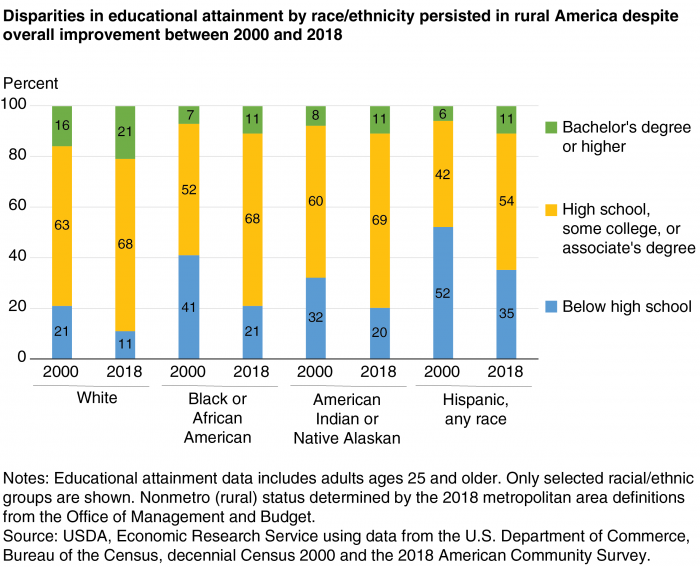Understanding Education as a Social Determinant of Health
Education impacts other key social determinants of health, not least of which include income and job security.

Source: Getty Images
- Education is a critical social determinant of health, largely because of its outsized impact on income and therefore other SDOH.
There’s some clear-cut evidence underscoring the impact education has on overall health and well-being. In 2021, researchers published in PNAS that folks with higher educational attainment tend to live longer. Adults with a bachelor’s degree are expected to live around 48.2 years out of a possible 50, compared to just 45.1 years for those without a college degree.
That’s likely a mixed result of the other social determinants of health that their education helped them circumvent and the good clinical outcomes apparent in those with higher education.
Healthcare experts have set their sights on education as a leading social determinant of health, with the Healthy People 2030 initiative from the Department of Health and Human Services outlining goals for education access and quality in particular.
“People with higher levels of education are more likely to be healthier and live longer,” initiative leaders say. “Healthy People 2030 focuses on providing high-quality educational opportunities for children and adolescents — and on helping them do well in school.”
Below, PatientEngagementHIT outlines educational attainment, education quality, how education connects to other SDOH, and how education connects to racial health disparities.
Educational attainment
Educational attainment refers to the degree to which an individual completed her education, ranging from some college all the way up to doctoral degrees. As illustrated in the PNAS data, attaining a higher degree of education is generally linked with better health, as measured by life expectancy.
That’s likely because higher educational attainment allows for greater access to other resources—mainly income—that help people ameliorate other social determinants of health like housing and food insecurity.
“In the early 1980s, median wages of prime-aged (25 to 54) workers with a 4-y degree were 40% higher than those without,” the PNAS researchers wrote. “This college wage premium had soared to 80% by the late 20-teens, in part through the rise in real wages for those with a BA and in part through the decline in real wages for those without.”
Said otherwise, getting a college degree makes it easier to afford other resources, staving off the impacts that food and housing insecurity, plus myriad other SDOH, have on well-being.
Higher educational attainment has also been linked with higher health literacy and ability to navigate the medical system, researchers wrote in a 2018 BMC Health Services Research study.
Better health literacy may also lead to better healthcare self-efficacy and care management. Health literacy, driven by education levels, has also been indicated as impacting patient access to care and preventive screenings.
Education quality
Education quality refers not to the level of education someone has, but how good the education was. Metrics like reading and math proficiency are critical here, as is the social environment in which a child learns.
Under-resourced schools or even an educational setting rife with bullying or community violence may lead to adverse childhood events (ACEs), which have a quantified impact on childhood well-being affecting individuals into adulthood.
Education quality is closely linked to built environment, Healthy People 2030 says.
Education and other SDOH
As emphasized above, education is a key social determinant of health largely because of how it impacts other social determinants of health. Educational attainment, in particular, is linked to job attainment and then income, which can influence the impact other SDOH have on individuals.
Particularly, education affects:
- Income
- Food security
- Housing security
- Access to transportation
- Neighborhood
Conversely, other social determinants of health may impact education. Family income, for example, can determine neighborhood, which dictates which public school a child will attend. Children from under-resourced schools may face barriers to educational attainment, Healthy People 2030 says, while kids in schools with bullying or violence problems may also face similar attainment barriers.
“Children from low-income families, children with disabilities, and children who routinely experience forms of social discrimination — like bullying — are more likely to struggle with math and reading,” the initiative says on its website. “They’re also less likely to graduate from high school or go to college. This means they’re less likely to get safe, high-paying jobs and more likely to have health problems like heart disease, diabetes, and depression.”
Kids from low-income families might also face impacts from weathering, or the exhaustion born from living in poverty. This can impact brain development, Healthy People 2030 says, and ultimately impact performance in school.
How education fuels racial health disparities
Education can impact racial health disparities largely because there are racial disparities in educational attainment. Institutional barriers keep some racial groups from attaining higher educational levels, and since education is a key social determinant of health, can impact overall well-being.
According to the 2021 American’s Health Rankings Health Disparities report from UnitedHealthcare, educational attainment emerged as one of the leading SDOH that contributes to racial health disparities.
Using three decades of data, the researchers found differences in health outcomes for those with a college degree and those without a high school diploma. Those who did not complete high school were more likely to have multiple chronic conditions, more likely to self-report poor health, and more likely to experience mental health challenges.
Those racial health disparities mirrored disparities in educational attainment, the UnitedHealthcare researchers found.
Per figures from the USDA, bachelor’s degree attainment is concentrated among White people, while more Black and Hispanic people have less than a high school degree.

Source: USDA
A separate study published in the Journal of the American Heart Association found a positive link between educational attainment and cardiovascular health, but because higher education is concentrated among White populations, those benefits aren’t apparent across all groups.
Moreover, educational attainment is not enough to overcome the impact race has on health, the study authors said. Among both the most and least educated Black people, cardiovascular health was still around the lowest in the study.
The authors concluded that closing racial education gaps will be crucial to achieving health equity.
Improving education, SDOH
Healthy People 2030 has set up numerous benchmarks ranging from educational attainment to education quality that should help bolster the health and well-being of the nation’s youth into adulthood.
Those benchmarks include getting 4th and 8th graders proficient or better math and literacy skills, increasing the number of students with disabilities in regular education classes, and increasing high school graduation and college enrollment rates.
Additionally, Healthy People 2030 has set up benchmarks for the number of young kids getting early intervention and mental health help.
Unfortunately, only a few of these metrics are getting better: 4th-grade math skills, the number of kids with disabilities in regular education classes, and the high school graduation rate.
Education is the great equalizer, but right now, educational equity is elusive. Improving education for all will help ameliorate it as a social determinant of health and ultimately improve health and well-being into adulthood.
